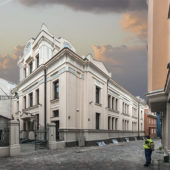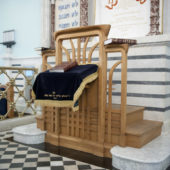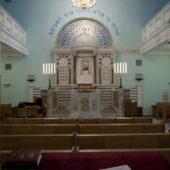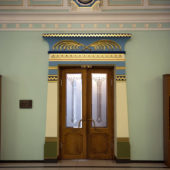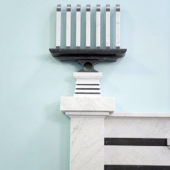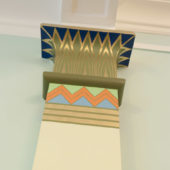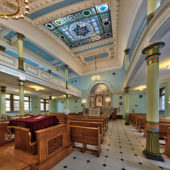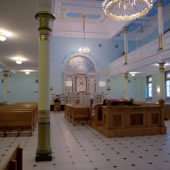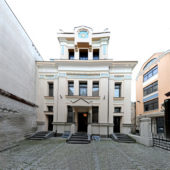The Riga Synagogue, also called Peitav Shul, is the sole survivor of Riga’s many synagogues. Although Jews have lived in Riga since the 1300s, the Jewish community of Riga celebrated its 100-year anniversary in 2005.
History of the Riga synagogue
By Gita Umanovska, executive director of the Riga Jewish Community
A Jewish congregation formed in Old Riga at the end of the 19th century. In 1903, its members purchased a plot of land on Peitavas Street and obtained permission for the construction of a synagogue.
The synagogue project was developed and carried out by two people – the outstanding architect and art historian Vilhelms Neimanis (1849 – 1919) and Hermanis Zeiberlihs (1878 – 1938), a young architect. Neimanis successfully fitted the synagogue building into an asymmetrical plot, placing it with the longitudinal façade along Peitavas Street. A small yard was created in front of the building’s Western façade allowing visitors to enter and exit the synagogue without disturbing the people and vehicles passing by. On the side of the plot along Small Peitavas Street a gateway was added and a two story outhouse constructed. Zeiberlihs created a project for the basement.
The initial project was altered and supplemented many times; construction work, however, was completed by 1905. The synagogue was named Peitav-Shul after its location.
In July 1941, after the Nazis entered Riga, all synagogues in the city were burnt down. Peitav-Shul was the only synagogue remaining, because of the risk of fire spreading to the nearby buildings. The synagogue was converted into a warehouse. After the war it turned out that the cabinet with the Torah scrolls had been kept hidden, and thus saved. It is believed that a pastor from a nearby church did so.
After the war, religious services were resumed in the synagogue. It was one of the few synagogues in the Soviet Union which was not closed down. In Soviet times, no money for repairs was granted. The few members of the congregation renovated and maintained the synagogue to the best of their own abilities.
Peitav-Shul is currently the only synagogue in Riga.
In 2007, the Riga Jewish Religious Community was granted financial support by the European Union and the Republic of Latvia for renovation of the synagogue. Thanks to this grant, the support of the Latvian Council of Jewish Communities, as well as donations by numerous organizations and individuals, wide scale renovation and restoration jobs took place in 2007 – 2008. As the result of this work, the Riga synagogue was restored to its former splendour, complementing the architectural palette of Old Riga.
Art Nouveau
The Riga synagogue on Peitavas Street is one of the few sacral buildings in Riga constructed in the Art Nouveau style. Its artistic image uses the language of Egyptian architectural forms and emphasizes a vertical rhythm. The façades are light, pastel colored with decorative white and light blue ornaments that feature classical and palm branch motifs. The synagogue building creates the impression of a resplendent Eastern-style building.
In the Art Nouveau interior of the synagogue Egyptian motifs have been masterfully used: the prayer hall’s entry portal expanding in the lower parts, crossed palm branches, columns with lotus-like capitals and papyrus leaf bases, pilasters, ornaments. The entire building is decorated with a geometrical ornament. However, the interior is not exaggerated, it’s reserved and refined.
The synagogue is a cultural monument of national significance and one of the most beautiful Art Nouveau buildings in Riga.

